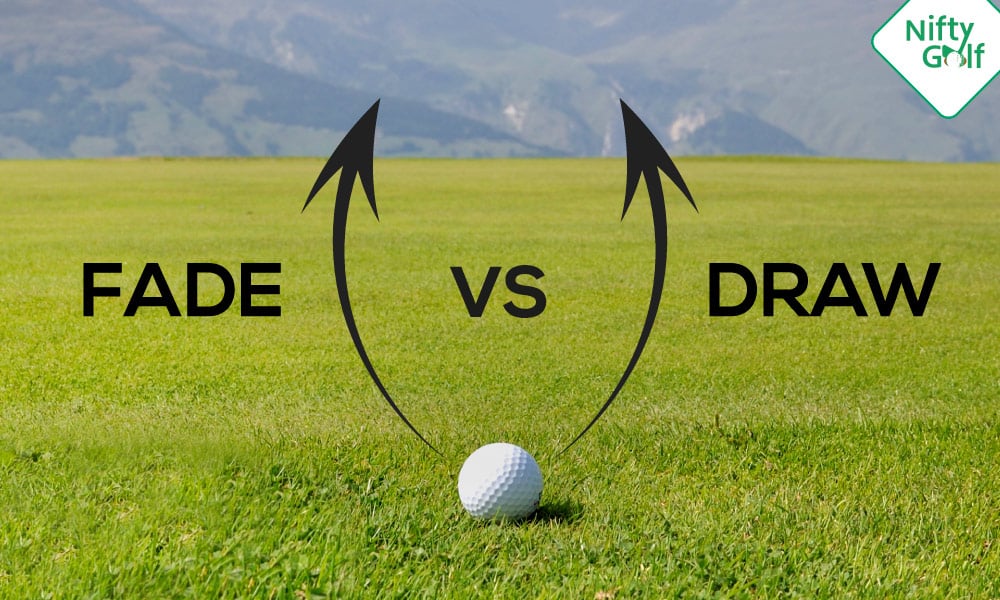Among the many techniques and shots that golfers use, the draw and fade shots are two of the most important and widely used. A draw shot causes the ball to curve from right to left, whereas a fade shot causes it to curve from left to right. Both shots take a lot of skill and practice to get right because you have to change the clubface and swing path precisely to get the desired effect.
Golfers who want to improve their game should know the difference between a draw and fade shots. That’s why we’ve compiled a complete guide to these two shots (Draw vs. Fade), including when to use them, how to do them, and their pros and cons.
So, to take your game to the next level, head to our guide and start practicing these essential golf shots immediately.
Table of Content
- What Is a Golf Draw Shot?
- What Is a Fade Shot?
- What is the difference between a draw & fade shot?
- Benefits Of Hitting A Draw Or A Fade
- What Are Common Mistakes Made When Trying to Hit a Draw or a Fade?
- When Should You Hit a Draw vs. Fade in Golf?
- Draw vs Fade, Which One Is Better for Your Game?
- Tips for Improving Your Draw and Fade
- Frequently Asked Questions
- Wrapping Up
What Is a Golf Draw Shot?
For a right-handed golfer, a draw shot is a stroke in which the ball is struck to arc beautifully to the left as it travels.
To create a draw, apply the left sidespin to the ball by angling the clubface slightly to the ball’s left upon impact.
This controlled shot begins to the right of the target line before bending back to align, providing strategic advantages such as negotiating obstacles or fighting a left-to-right wind.
Pros of Hitting a Draw Shot
- A well-executed draw shot can provide more distance than a straight shot. The little curve can help the ball travel farther.
- Draws are renowned for their trajectory control. Golfers can utilize draws to maneuver around obstacles or to alter their strokes based on the course layout.
- A draw can help you get into a better position for your next shot by giving you a better angle of approach to the green.
- A draw can resist crosswinds in certain weather conditions, allowing greater precision.
Cons of Hitting a Draw Shot
- Learning to master the draw shot can be difficult, especially for beginners. It necessitates precise control of the clubface angle and swing path.
- If not completed correctly, a draw might convert into a hook, resulting in a loss of accuracy.
How To Hit a Draw Shot
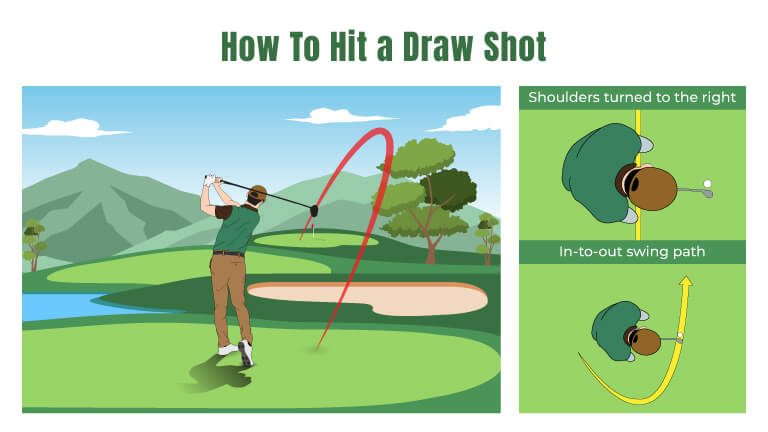
Follow these step-by-step instructions on how to hit a draw shot:
- Begin by pointing your club directly at the target. This establishes the initial direction of your shot.
- Align your body slightly to the right of where you want the ball to land (if you are a right-handed golfer). This prepares the ball for a right-to-left flight.
- Close your body and swing straight, keeping the clubface square to the ball at impact. With the closed body position and this planned swing path, the ball will start to the right of the target and curve back from right to left, giving the player the draw they want.
What Is a Fade Shot?
A golf fade shot is a controlled golf shot that drifts slightly from left to right throughout its flight for right-handed players (and vice versa for left-handed golfers).
The fade is accomplished by giving the ball a particular spin, which causes it to go gently from left to right. The shot begins to the left of the target line and curves back towards it. This skill is handy if the wind blows from right to left or you need to get around objects requiring the ball to fly left to right.
Pros of Hitting a Fade Shot
- The fade shot is considered easier to control than the draw shot because it gives golfers a more predictable and manageable trajectory.
- Fades have a higher trajectory, which makes them useful when aiming for a tucked flag or playing on quick and challenging courses.
- The fade shot frequently results in a softer landing, which helps with control when approaching the green.
- Golfers like fades because they can accurately place the ball on the fairway or near the target.
Cons of Hitting a Fade Shot
- The fade is easier than a draw, but executing consistently requires practice.
- An incorrect fade can convert into a slice, causing the ball to deviate right and potentially affecting accuracy.
How To Hit a Fade Shot
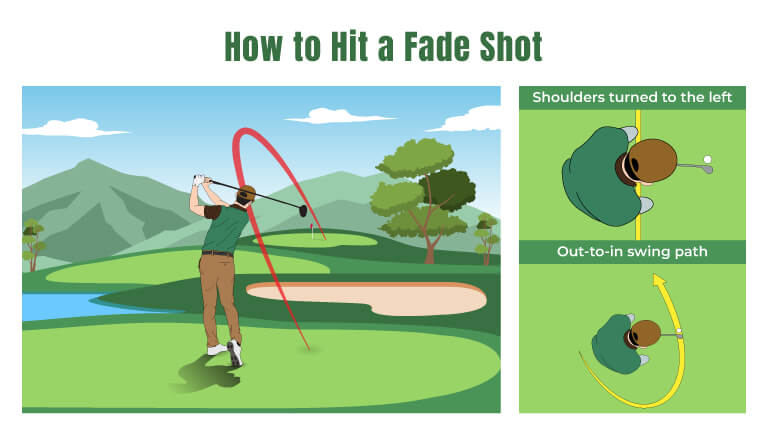
To hit a fade shot in golf, just follow these easy steps:
- Aim the face of the club straight at your goal or just slightly away from it.
- You should face the target to the left, with your body angled so the line connecting your right and left toes points left.
- Make sure that when you hit the ball, the clubface stays pointed at the goal by swinging along the path of your body.
When executed correctly, the ball will start its journey left of the target, along the line of your body’s alignment, before gently bending from left to right, indicating the intended direction of the clubface.
By keeping your body aligned with the clubface, you can avoid a slice by keeping the club’s path from diverging too much from yours.
What is the difference between a draw & fade shot?
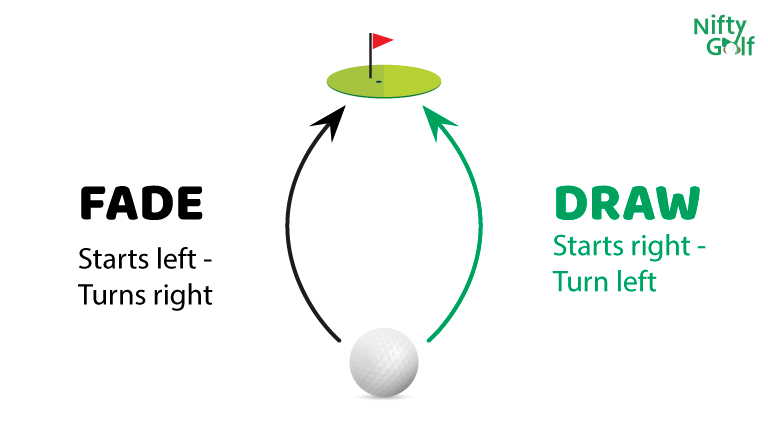
Here are the differences between a draw and a fade shot:
Draw
- A draw shot goes right and then curve left.
- Won’t turn very far to the left, unlike a hook.
- Right-handed players can do this by spinning the ball in a clockwise direction.
- Helpful in getting around obstacles on the left side of the fairway or setting up a soft landing approach shot to the green.
Fade
- A fade shot goes left then curve right.
- Most common shot shape for players
- It can be on purpose or the result of a natural swing or adjustments made to control the ball.
- A right-handed player can spin the ball counterclockwise to achieve a draw shot.
- Helpful in avoiding obstacles on the right side of the fairway or setting up an approach shot to the green that needs the ball to roll out further.
Now that you know the difference between fade shots and draw shots, we’ll look at both in more detail to help you understand them better.
Benefits Of Hitting A Draw Or A Fade
Practice using different shot shapes to improve your tee and approach shot from the fairway. For example, well-done draw shots can help avoid bunkers, trees, and water. In addition, being able to control the trajectory of your shot by drawing the ball is helpful in many situations, including when the wind is blowing against you or when you have a complicated play on the fairway.
- When faced with a “dogleg left,” many golfers believe a draw is the most effective shot. You may have the best chance of getting closer to the hole than with any other shot form if you curve the ball around the leftward bend.
- You can improve your game’s accuracy and consistency by mastering the difference between the draw and fade shot shapes.
- You can use both draw and fade shots to adjust the course’s natural contours and the wind’s direction.
- By learning to hit a draw and fade shots, you can avoid hazards, use the course’s terrain to your advantage, and control the ball’s flight path. With enough practice, these shots can become very useful for any player.
What Are Common Mistakes Made When Trying to Hit a Draw or a Fade?
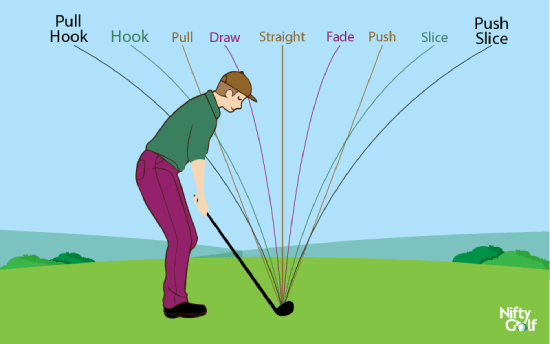
Hit a draw, or a fade can help your shots get around different course layouts. But it’s easy to make the same mistakes that lead to misses or a lack of control. Here are some tips to help you avoid making these mistakes when trying to hit a draw or a fade.
- Make sure your setup is perfect and swing as you usually would; rather than trying to modify the club face throughout the swing, you will hit draws and fades easily.
- You’ll have a lot of trouble hitting the target if you don’t adjust your aim for the club you’re using; the longer your club, the more it will draw, so aim appropriately.
- If you’re holding the club too firmly, you might not be able to let it impact.
- You can’t hit a draw if the club face is exposed at impact.
- Less effort usually means more control, and a steady tempo makes maintaining power and precision easier.
- center of the ball, you should focus on hitting it straight.
When Should You Hit a Draw vs. Fade in Golf?
If you know when to hit a draw or a fade in golf, you can do much better on the course. Here are some situations where one shot shape might be better than the other:
When to hit a draw:
- When you need to hit the ball further, a draw tends to go farther than a fade because it makes more backspin.
- When you need to curve the ball around an obstacle, a draw can help you do that.
- A draw is the best shot when the hole curves to the left because it helps keep the ball on the fairway and gives you more distance.
When to hit a fade:
- When you need to control your shot, a fade usually has less side spin, which makes it easier to control where the ball goes and where it lands.
- When the hole curves to the right, a fade can help you stay on the fairway and out of trouble.
- When you need to hit a shot into the wind, a fade can help you hit the ball higher and with less backspin, which helps it cut through the wind and stay on course.
Draw vs Fade, Which One Is Better for Your Game?
It depends on the situation. In some situations, a draw shot is preferable for avoiding risks and using terrain. In other circumstances, a fade shot may be required to hit a specific target or layup before a hazard. Finally, knowing when and how to hit fade and draw shots will help you succeed on the course.
Whether you’re trying to hit a draw or a fade, knowing you can make the shot will give you more confidence and help you make more putts.
Most golfers think that a draw has more possibility than a fade, but it’s important to remember that a fade can be used when there are only a few possible directions. It’s also important to remember that, despite what some golfers might say, a draw still requires the correct opening of the club face while keeping it in a square position.
Tips for Improving Your Draw and Fade
Some tips to remember to better your draw or fade stroke in golf are provided below.
- An effective way to keep track of the development of your draw or fade is with a launch monitor. It records your swing and provides statistics like side spin, ball speed, and shot pattern. To help you fine-tune your golf swing, a launch monitor will show you how far you’ve come as you practice.
- Before attempting to shape your shot, you should ensure total command of your swing and ball striking.
- Exercising these shots is the greatest way to master them. If you aren’t entirely comfortable with these shots, it’s best to practice them before instead of trying to use them in a game round, where they’ll likely cause you to lose both confidence and shots.
- Choose which shot suits your swing best and which you feel most comfortable striking. Stick to the one you know you can make.
- When playing golf, the most important thing is to enjoy yourself. Don’t obsess over shot shape and self-criticism. In addition to aiming for the
Frequently Asked Questions
What is the difference between a draw and a slice?
The main difference in golf between a draw and a slice is how sharp the curve is. A draw is a predictable shot with a slight bend from right to left (for right-handed golfers) or left to right (for left-handed players).
Conversely, a slice is an exaggerated and less controlled ball flight that curves unexpectedly from left to right (for right-handed players) or right to left (for left-handed golfers), frequently causing problems on the golf course.
What is the difference between a draw and a pull in golf?
The main difference between a draw and a pull in golf is the direction of the ball’s flight. A draw is a shot intended to curve from right to left, with the ball beginning to the right of the target.
On the other hand, a pull is an unplanned shot that begins to the left of the target and continues along that line. Even though a pull has a great range, it often lacks the needed accuracy. Draws, on the other hand, are executed with precision for maximum control.
Wrapping Up
Among the many ways to shape a golf shot, the draw and the fade are two of the most common and versatile. Both draw and fade serve a similar function, although the latter requires a more consistent and exact swing to achieve the former’s desired trajectory.
Now that you know the difference between a draw and a fade, it’s time to practice your swing at the driving range. The more you practice these shots, the closer you’ll go to making those putts.

